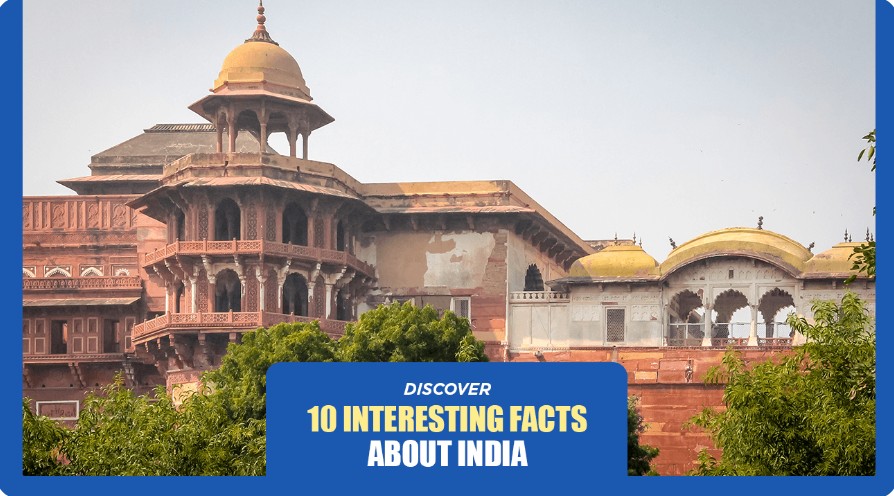
The most populous country in the world, home to over 1.4 billion people, 22 official languages, incredible natural landscapes, world-class cuisine, and much more, it’s no small wonder why India has become an increasingly popular tourist destination in recent years. Today with Whatsgoingindia, we’re going to share 10 fun facts about India that you probably didn’t know. We’ll also suggest some of the most exciting ways to discover this fascinating South Asian country!

1. India Is the Most Vegetarian Country
According to a recent study, the country with the highest proportion of vegetarianism is India, with a staggering 38% of the population identifying as vegetarian. There are a number of reasons why there is such a high rate of vegetarians in the country, and why a large number of people also limit their meat consumption (around 80%!). A significant factor is that all of India’s most widely practised religions have dietary laws and traditions.
As such, it stands to reason that India is an excellent country to visit for vegetarians. Of course, it has lots of restaurants and street food which cater to vegetarians! The vast majority of Jains (92%) describe themselves as vegetarian, while a small minority of Muslims and Christians (8-10%) claim the same. Hindus split the difference, with about 45% describing themselves as a vegetarian.
2. The Taj Mahal is Not a Palace…
Thought by many to be a palace, the iconic Taj Mahal, one of the new 7 Wonders of the World, is in fact a mausoleum. Commissioned by the Mughal Emperor Shah Jahan in memory of his beloved wife, the Taj Mahal was constructed between 1632 and 1653. The architectural masterpiece is renowned for its symmetrical beauty and exquisite craftsmanship and was designated a UNESCO World Heritage Site in 1983. The Taj Mahal is the jewel of Muslim art in India and one of the universally admired masterpieces of the world’s heritage.
3. India is the Tiger Capital of the World
With a roaring population of 3,682 tigers India proudly holds the title of the tiger capital of the world. Incredibly, a whopping 75% of the global tiger population calls the country home. These majestic creatures roam across various landscapes in India, from dense forests to grasslands. The tiger population hit an all-time low in the 1970s, leading to an increased effort to preserve the tiger population. Thanks to the establishment of reserves, anti-poaching measures, and awareness campaigns, the tiger population today is growing by approximately 6% annually.
- Madhya Pradesh is known as the “Tiger State” of India, with a high density of tigers, making it a popular destination for tiger safaris.
- Nagpur is also referred to as the “Tiger Capital of India” as it is a hub for connecting to many tiger reserves in the country.
4. Hinduism is the Oldest Religion on the Planet
India’s largest religon, practiced by nearly 80% of the poulation is considered by many to be the oldest religious tradition in the world. Incredibly, the religion has roots and customs dating back more than 4,000 years! Hinduism is really a broad, umbrella term which encompasses a wide range of beliefs, practices and philosophies. As such, this fact about India a somewhat controversial one among scholars!
Hinduism is Called as Sanatan Dharma where “Sanatan” means Eternal which has no End. The Sanatan Dharma ( Hinduism, Jainism, Budhism and Sikhism ) is way of life which is adopting new Changes of Society rather than opposing it. The Rock Paintings of Bhimbetka suggests that Hinduism was followed around 8000 BCE in Tribal Form. The Painting Portrays Lord Shiva.
5. Cows have sacred status
Somewhat related to the entry about vegetarianism, many people are aware cows are sacred in India. This comes down to the cow’s importance in some of the nations primary religions, principally Hinduism, but also Jainism and Buddhism.
In ancient Hindu texts, the cow appears as “Kamdhenu” or the ‘divine cow’. It is believed to be the earthly symbolizes wealth, strength, and motherly love.
6 . India is Home to Some of the World’s Oldest Continuously Inhabited Cities
The oldest of India’s continuously inhabited cities is it’s spiritual capital of Varanasi, also known as Kashi or Benaras located along the banks of the sacred Ganges River. Incredibly, this North Indian city has a 3000+ year history dating back to at least 1200 BCE. Varanasi’s history is steeped in ancient texts like the Puranas, Vedas, and Mahabharata, suggesting its existence for millennia.
Today the city is known as the cultural capital of India. With its winding streets, ancient temples, bustling markets and much more, this is certainly a city worth visiting! Indraprastha (Now Delhi) is also World’s Oldest Continuously Inhabited City in India established as the ancient city (c. 1200 – c. 900 BC).
7. ‘Snakes and Ladders’ comes from India
One of the most popular games of all time, not many people know that this household classic originated from the nation of India, where it was known as “Moksha Patam” or “Gyan Chaupar”, with a history dating back to the 2nd century BC. Some historians place its history even further back, to the 13th century BC! The game was originally used as a tool for moral instruction, Where The ladders represented virtues such as generosity, faith, and humility, while the snakes represented vices such as lust, anger, murder, and theft. The game was later introduced to the West, where it was adapted and renamed “Snakes and Ladders”.
8. Staggering linguistic diversity
Second only to the United States of America, 10% of india’s population (125 million people) are fluent in English, and around 30% of the population can speak English to a certain level.
Even more interesting is that English is one of 23 officially recognised languages spoken in the country. In fact, there are many more languages than that spoken in the country, with over 19,500 languages/dialects recorded as mother tongues in the 2018 census.
9. India is the Largest Producer of Films in the World
A lesser-known fact about India is that it is the world’s largest film producer and boasts the second-oldest film industry globally. With an extensive domestic following and a substantial international audience, the impact of Indian cinema is significant and far-reaching. At the forefront of this cinematic landscape is Bollywood in Mumbai—a dynamic and influential component of Indian cinema.
10. Anti-Gravity Hill?
The Magnetic Hill in Ladakh, India, is an intriguing natural wonder that seemingly defies the laws of gravity. Located on the Leh-Kargil-Baltic National Highway, this hill creates an optical illusion making it appear as though vehicles are rolling uphill against gravity when they are actually moving downhill. Still, tourists from around the world flock to the site to witness this phenomenon.
While these were 10 of our favourite facts about India, there’s plenty more to discover!
10 Most Interesting Facts about our India, most amazing facts about india, surprisingly facts of india, Top 10 Fascinating Facts About India,






